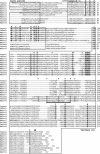Molecular cloning and expression analysis of peptidase genes in the fish-pathogenic scuticociliate Miamiensis avidus
- PMID: 23311870
- PMCID: PMC3599101
- DOI: 10.1186/1746-6148-9-10
Molecular cloning and expression analysis of peptidase genes in the fish-pathogenic scuticociliate Miamiensis avidus
Abstract
Background: Parasite peptidases have been actively studied as vaccine candidates or drug targets for prevention or treatment of parasitic diseases because of their important roles for survival and/or invasion in the host. Like other parasites, the facultative histophagous ciliate Miamiensis avidus would possess peptidases that are closely associated with the invasion into the host tissue and survival in the host.
Results: The 17 genes encoding peptidases, including seven cathepsin-like cysteine peptidases, four serine carboxypeptidases, a eukaryotic aspartyl protease family protein, an ATP-dependent metalloprotease FtsH family protein, three leishmanolysin family proteins and a peptidase family M49 protein were identified from a Miamiensis avidus cDNA library by BLAST X search. Expression of genes encoding two cysteine peptidases, three leishmanolysin-like peptidases and a peptidase family M49 protein was up-regulated in the cell-fed ciliates compared to the starved ciliates. Especially, one cysteine peptidase (MaPro 4) and one leishmanolysin-like peptidase (MaPro 14) were transcribed more than 100-folds in the cell-fed ciliates.
Conclusions: The genetic information and transcriptional characteristics of the peptidases in the present results would be helpful to elucidate the role of peptidases in the invasion of scuticociliates into their hosts.
Figures


Similar articles
-
Sequence conservation in the internal transcribed spacers and 5.8S ribosomal RNA of parasitic scuticociliates Miamiensis avidus (Ciliophora, Scuticociliatia).Parasitol Int. 2011 Jun;60(2):216-9. doi: 10.1016/j.parint.2011.02.004. Epub 2011 Mar 21. Parasitol Int. 2011. PMID: 21362496
-
Pathogenicity of Miamiensis avidus (syn. Philasterides dicentrarchi), Pseudocohnilembus persalinus, Pseudocohnilembus hargisi and Uronema marinum (Ciliophora, Scuticociliatida).Dis Aquat Organ. 2009 Feb 12;83(2):133-43. doi: 10.3354/dao02017. Dis Aquat Organ. 2009. PMID: 19326794
-
Removal of two pathogenic scuticociliates Miamiensis avidus and Miamiensis sp. using cells or culture filtrates of the dinoflagellate Alexandrium andersonii.Harmful Algae. 2017 Mar;63:133-145. doi: 10.1016/j.hal.2017.02.002. Epub 2017 Feb 27. Harmful Algae. 2017. PMID: 28366388
-
Scuticociliatosis and its recent prophylactic measures in aquaculture with special reference to South Korea Taxonomy, diversity and diagnosis of scuticociliatosis: Part I Control strategies of scuticociliatosis: Part II.Fish Shellfish Immunol. 2010 Jul;29(1):15-31. doi: 10.1016/j.fsi.2010.02.026. Epub 2010 Mar 6. Fish Shellfish Immunol. 2010. PMID: 20211263 Review.
-
Host responses against the fish parasitizing ciliate Ichthyophthirius multifiliis.Vet Parasitol. 2001 Sep 12;100(1-2):105-16. doi: 10.1016/s0304-4017(01)00487-3. Vet Parasitol. 2001. PMID: 11522410 Review.
Cited by
-
Transcriptomic Differences between Free-Living and Parasitic Chilodonella uncinata (Alveolata, Ciliophora).Microorganisms. 2022 Aug 15;10(8):1646. doi: 10.3390/microorganisms10081646. Microorganisms. 2022. PMID: 36014062 Free PMC article.
-
Characterization of the complete mitochondrial genome of Miamiensis avidus causing flatfish scuticociliatosis.Genetica. 2022 Dec;150(6):407-420. doi: 10.1007/s10709-022-00167-5. Epub 2022 Oct 21. Genetica. 2022. PMID: 36269500
-
Interactions between the Parasite Philasterides dicentrarchi and the Immune System of the Turbot Scophthalmus maximus. A Transcriptomic Analysis.Biology (Basel). 2020 Oct 15;9(10):337. doi: 10.3390/biology9100337. Biology (Basel). 2020. PMID: 33076342 Free PMC article.
-
Transcriptome Analysis of Amyloodinium ocellatum Tomonts Revealed Basic Information on the Major Potential Virulence Factors.Genes (Basel). 2020 Oct 24;11(11):1252. doi: 10.3390/genes11111252. Genes (Basel). 2020. PMID: 33114415 Free PMC article.
References
-
- Rosenthal PJ. Proteases of protozoan parasites. Adv Parasitol. 1999;43:105–159. - PubMed
-
- Jime’nez JC, Uzcanga G, Zambrano A, Di Prisco MC, Lynch NR. Identification and partial characterization of excretory/secretory products with proteolytic activity in Giardia intestinalis. J Parasitol. 2000;86:859–862. - PubMed
Publication types
MeSH terms
Substances
LinkOut - more resources
Full Text Sources
Other Literature Sources
Research Materials

